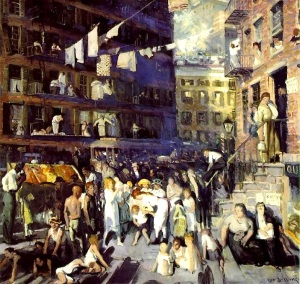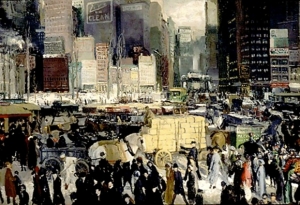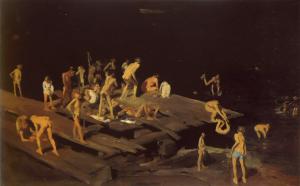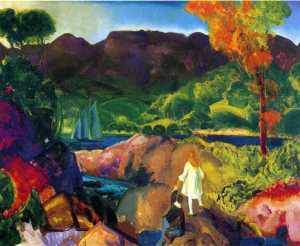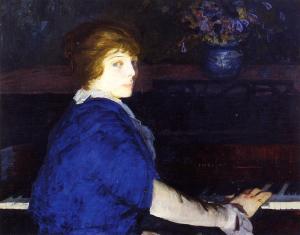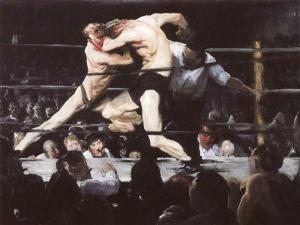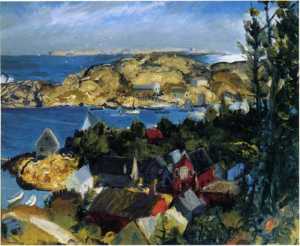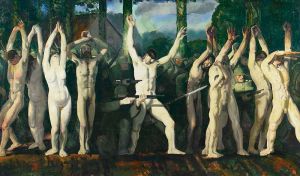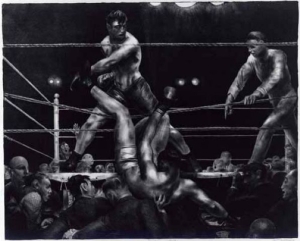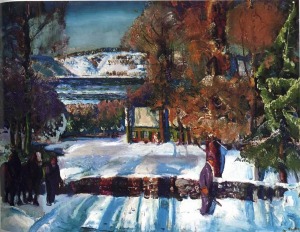“Others paved the way and I came at the psychological moment.”
Men of the Docks (1912), oil on canvas, Lynchburg, Virginia, Randolph College, Maier Museum of Art
George Wesley Bellows was American through and through. As one of the nation’s finest realist painters, Bellows was admired as one of the most accomplished artists of his generation. Even at his death, some claimed he was even more so acclaimed than his contemporary and friend Edward Hopper. There was vitality to all his works – from landscapes to action scenes – which cemented his reputation and notoriety in American art history.
Cliff Dwellers (1913), oil on canvas, Los Angeles County Museum of Art
EARLY LIFE
Born in Columbus, Ohio in 1882, George Wesley Bellows was a skilled baseball player and went on to play for Ohio State University from 1901-04. Along with his athletic prowess he also had a creative side which he employed through his illustration contributions for the school’s yearbook. While many urged him to continue a career in baseball, he soon dropped his interest in sports to focus on his true passion of art. He was a highly sought-after illustrator but wanted to pursuit a role as a painter. In order to follow his dream, he moved to New York City in 1904 just before completing graduation.
New York (1911), oil on canvas, Washington DC, National Gallery of Art
HENRI’S INFLUENCE AND THE ASHCAN SCHOOL
In New York, Bellows studied under the tutelage of Robert Henri at the New York School of Art. Henri was “anti-establishment” and a big opponent of the traditionalism in American art. He made such an impact on the Bellows’s career and life that at one point the young protégé referred to Henri as “my father.”
Like Henri, Bellows took a job as an art instructor at the Art Students League in 1908 (and in that same year for a six-week course at UVA – Wahoowah!) to support his new bride and fellow art student, Emma Story. However, unsatisfied with this line of work, Bellows soon returned to painting fulltime.
Because of his association with Henri and his talent, Bellows was integrated into what became known as the Ashcan School. Originated by members of “The Eight,” the Ashcan School was a group of artists who promoted the creation of works of contemporary urban life at all levels. Known for their use of dark tones, the Ashcan School was in fact a critically ascribed name as the artists were said to have been inspired by the back alley dwellers of urban city life in New York.
Bellows’s focus on the working class in a crude but truthful manner gave him notoriety as he began to exhibit along with other Ashcan artists. In 1908, “The Eight” exhibited at the MacBeth Gallery in protest against the supposed National Design Academy’s judging prejudices. Their efforts did not go unnoticed and shortly after the showcase, the NDA began opening their doors to members of the Ashcan School. Bellows however opted out of the exhibition as he was in Ohio recovering from an illness. However, his absence may have aided his popularity as he did not take such an adamant stance against the academic side of art.
Forty-Two Kids (1907), oil on canvas, Washington DC, Corcoran Gallery of Art
EMERGENCE
Bellows became the youngest elected associate member of the National Academy of Design in 1909 and exhibited with the NDA until 1919. Yet he also proved himself as one of their opponents through his inclusion in the 1913 Armory Show (where he exhibited Both Members of the Club along with 8 other works) and the Exhibition of Independent Artists in 1919.
Both Members of This Club (1909), oil on canvas, Washington DC, National Gallery of Art
The Armory Show, originally headlined under the name 1913 International Exhibition of Modern Art, served as an outlet for American artists to assert a new identity against the European mainstream model. The effect on the American art scene was one of polarization from awe to atrocity. It introduced European modernism to the classical American art scene and had a profound effect on Bellows. Specifically, The Armory Show of 1913 opened Bellows eyes to the forms of cubism and the works of Renoir. Bellows was inspired by these new artistic theories and it transformed his art as he developed his use of color.
Romance of Autumn (1916), oil on canvas, Farnsworth Art Museum, Rockland, ME
PORTRAITS
His gaining notoriety brought an invitation into the world of New York’s social elite. As a result of this inclusion, Bellows’s had a large demand for commissioned portraits. Even though this genre expansion was indebted to his newfound fame, portraiture was always a mainstay in his oeuvre. Using Eakins, Homer and Whistler as influences, Bellows was able to promote his sitters with a sense of emotional power and intense expression. He often painted his wife, Emma, and daughters, Anne and Jean, along with his privileged clientele but became frustrated with the demands of commissions and limited his sitters to family and friends later on in his career.
Emma at the Piano (1914), oil on canvas, Norfolk, Virginia, Chrysler Museum of Art
SPORTING ART
Despite his many achievements, Bellows’s greatest contribution to American art may arguably be his sporting works –most notably of boxing matches. Highlighted by strokes of gritty motion and active intensity, the sights and sounds of the underground 1910s and 20s boxing movement truly come to life in these scenes. Tom Sharkey’s saloon, the setting of his most famous work Stag at Sharkey’s (1909), was a place Bellows frequented – despite the fact that boxing was illegal in New York at the time. In the present work, Bellows portrays an ultra-masculine scene with broad and rapid strokes that reflect the raw grittiness of these underground fights. With this work, Bellows cemented his reputation as a painter capable of portraying a sense of bold vitality. However, there was both a psychical power and emotional power to his works that was not restricted to simply his action scenes (as is evident from a mere glance over his oeuvre).
Stag at Sharkey’s (1909), oil on canvas, The Cleveland Museum of Art
LANDSCAPES
A pleasure trip in 1911 began what would become a lifelong expedition of summers to the countryside of Maine, New York and Rhode Island whose scenes inspired many of his bucolic landscapes. His works in this genre vary from landscapes to seascapes but all assert both literally and figuratively a breath of fresh air to the American vista.
Mantinicus from Mount Ararat (1916), oil on canvas, Private collection
POLITICAL AFFILIATION
Along with his artistic inclinations, Bellows was an active participant in domestic political issues. He was a staunch critic of the government’s media censorship of the war and Bellows publically supported the US intervention in World War I. He even incorporated these modern events into his works as evidenced in many of his war scenes – many of which depict the events of the German invasion of Belgium. Joseph Pennell claimed that because Bellows had not seen the atrocities of war first hand that he was not fit to paint it to which Bellows retorted: “I was not aware Leonardo da Vinci had a ticket to paint the Last Supper.” (badass!)
The Barricade (1918), oil on canvas, Birmingham Museum of Art
PRINTING
Bellows was also an avid lithographer and pioneer of the modern methodology. This practice involves using greasy drawing material (sometimes crayons or pencils) to draw a mirrored image of the artwork usually onto a smooth stone tablet or metal plate. Bellows focused on this new form of medium later on in his life – even buying his own lithography press for his studio in 1916. His prints number over 200 and his most famous, Dempsey and Firpo, was widely distributed and well-known.
Dempsey and Firpo (1923-24), lithograph, Private collection
HIS ART
Bellows was constantly walking the line between conservative critics and the progressive American art movement. He had a vast array of styles and subject and his works were riddled with social messages. His work often satirized the upper class (for example, the way he portrays the audience of Both Members as animalistic, grotesque individuals) and he had the ability to portray the stress of the everyday. His scenes offered a true view of urban life which he captured with an immediacy and boldness. He was never one to shy away from his views both socially and politically and this proved to enhance his works with verity and audacity.
As he progressed in his practice, his focus gravitated towards a strong sense of light and texture – specifically seen in his snowfall works where he truly mastered his sense of color demonstrated his handling of paint. Later in his career, Bellows was influenced by Jay Hambridge, a mathematical theorist who coined the system of “dynamic symmetry” and the artist began incorporating geometrical theory into his compositions. With this vast array technical tools in his pocket, Bellows was able to bring life the tamest of scenes and add a punch (both literally and figuratively sometimes) to those that seemed unable to contain so much action. It was not uncommon for Bellows to complete 2 to 3 works per day which should not be viewed as nonchalant haste but a reflection of the power and movement of his works. His art is an amalgamation of the energy, clutter and vibrancy that is life.
Sadly, Bellows died at the height of his career at the age of 42 of peritonitis which resulted from complications with his ruptured appendix. From this, we are left wondering that if his life had not been cut short, where he would have taken art well into the mid-late 20th century.
Winter Road (1912), oil on canvas, San Diego Museum of Art
COLLECTIONS CONTAINING HIS WORKS (courtesy of Quest Royal Fine Art):
Addison Gallery of American Art, Andover, MA
Amon Carter Museum, Forth Worth, TX
Art Institute of Chicago
Ball State Museum of Art, Muncie, IN
Blanton Museum of Art at the University of Texas, Austin, TX
Block Museum of Art at Northwestern University, Chicago
Boston Public Library
Brauer Museum of Art at Valparaiso University, IN
Brooklyn Museum
Bruce Museum of Arts and Science, CT
Canton Museum of Art, OH
Carnegie Museum of Art, Pittsburgh
Cedarhurst Center for the Arts, Mt. Vernon, IL
Cleveland Museum of Art
Columbus Museum of Art, OH
Corcoran Gallery of Art, Washington DC
Crystal Bridges Museum of American Art, Bentonville, AK
Currier Gallery of Art, NH
Dallas Museum of Art
Davis Museum and Cultural Center at Wellesley College, MA
Detroit Institute of Arts
Farnsworth Art Museum, Rockland, ME
Fine Arts Museums of San Francisco
Five College Museums, Massachusetts
Frick Art and Historical Center, Pittsburgh
Harn Museum at the University of Florida, Gainesville
Harvard University Art Museums, MA
Hirshhorn Museum and Sculpture Garden, Washington DC
Hunter Museum of American Art, TN
Indianapolis Museum of Art
Butler Institute of American Art, OH
Joslyn Art Museum, NE
Lauren Rogers Museum of Art, Laurel, MS
Los Angeles County Museum of Art
Maier Museum of Art at Randolph-Macon Woman’s College, VA
Memorial Art Gallery of the University of Rochester, NY
Metropolitan Museum of Art
Mildred Lane Kemper Art Museum, St. Louis
Milwaukee Art Museum, WI
Minneapolis Institute of Arts, MN
Museum of Fine Arts, Boston
Museum of Fine Arts, Houston
Museum of Modern Art, NY
National Academy Museum & School of Fine Arts, NY
National Art Museum of Sport at Indiana University, IN
National Gallery of Art, Washington DC
North Carolina Museum of Art, Raleigh
Norton Museum of Art, West Palm Beach, FL
Oklahoma City Museum of Art
Pennsylvania Academy of the Fine Arts, Philadelphia
Portland Museum of Art, ME
Princeton University Art Museum, NJ
Reading Public Museum, PA
Ruth Chandler Williamson Gallery at Scripps College, CA
San Diego Museum of Art
Santa Barbara Museum of Art
Sheldon Museum of Art, Lincoln, NE
Smithsonian American Art Museum, Washington DC
Springfield Museum of Art, OH
Telfair Museums, Savannah, GA
Terra Foundation for American Art, Chicago
The Huntington Library, CA
The Phillips Collection, Washington DC
Thyssen-Bornemisza Museum, Madrid, Spain
Toledo Museum of Art
U.S. Library of Congress, Washington DC
Virginia Museum of Fine Arts, Richmond
Westmoreland Museum of American Art, Greensburg, PA
Whitney Museum of American Art
Wichita Art Museum, KS
Williams College Museum of Art, MA
Worcester Art Museum, MA
Yale University Art Gallery, New Haven, CT
BIBLIOGRAPHY
http://en.wikipedia.org/wiki/George_Bellows
http://www.askart.com/askart/b/george_wesley_bellows/george_wesley_bellows.aspx
http://www.hvallison.com/Default.aspx
http://www.questroyalfineart.com/artist/george-bellows
http://www.wisegeek.org/what-is-a-lithograph.htm
http://www.nationalacademy.org/collections/artists/detail/152/
http://www.britannica.com/EBchecked/topic/59940/George-Wesley-Bellows
http://www.artinthepicture.com/artists/George_Bellows/Biography/
http://www.tfaol.com/newsmu/nmusi8e.htm
http://www.kingsacademy.com/mhodges/11_Western-Art/27_Popular_Modern-Realism/Bellows/Bellows.htm

